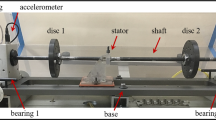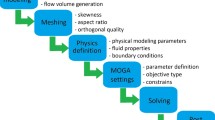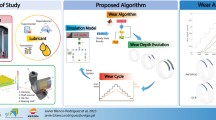Abstract
This paper presents an optimization-based methodology to predict the bearing coefficients from the measured dynamic responses in a rotor supported on floating ring bearings. The speed-dependent unknown direct and cross-coupled bearing stiffness and damping coefficients of the ideal rotor system are identified by predicting the deviations in frequency response amplitudes of ideal and actual rotor systems. The objective function is defined in terms of the total error in radial displacement amplitudes at the two bearing nodes during each operating speed. The modified particle swarm optimization (MPSO) scheme is employed to minimize the objective function subject to the variable limits. The approach also considers an equivalent spring-damper bearing system for simulations along with experimental work. The methodology is illustrated with three case studies namely (1) both the actual and ideal systems considered linear, (2) both actual and ideal systems are nonlinear, and (3) parameter estimation from experimental data. It is observed that the reliable stiffness and damping parameters are predicted with relatively less computational time. Furthermore, the accuracy of predicted parameters is verified by adding the varied amounts of Gaussian white noise signals to the measured responses and identified parameters are found to be within 3% accuracy. Further, the first four critical speeds of the rotor system are identified as 2200 rpm, 2424 rpm, 6120 rpm, and 6330 rpm respectively. The approach is relatively simple and can be applied to any kind of bearings.
























Similar content being viewed by others
Code availability
The custom codes are available on the authors’ page.
References
Papadopoulos CA, Nikolakopoulos PG, Gounaris GD (2008) Identification of clearances and stability analysis for a rotor-journal bearing system. Mech Mach Theory 43:411–426
Han F, Guo X, Gao H (2013) Bearing parameter identification of rotor-bearing system based on Kriging surrogate model and evolutionary algorithm. J Sound Vib 332:2659–2671
Zhou J, Di L, Cheng C et al (2016) A rotor unbalance response based approach to the identification of the closed-loop stiffness and damping coefficients of active magnetic bearings. Mech Syst Signal Process 66–67:665–678
Jin C, Xu Y, Zhou J, Cheng C (2016) Active Magnetic bearings stiffness and damping identification from frequency characteristics of control system. Shock Vib 2016:e1067506
Jiang K, Zhu C, Chen L, Qiao X (2015) Multi-DOF rotor model based measurement of stiffness and damping for active magnetic bearing using multi-frequency excitation. Mech Syst Signal Process 60–61:358–374
Asgharifard-Sharabiani P, Ahmadian H (2015) Nonlinear model identification of oil-lubricated tilting pad bearings. Tribol Int 92:533–543
Chandra NH, Sekhar AS (2016) Nonlinear damping identification in rotors using wavelet transform. Mech Mach Theory 100:170–183
Chen Y, Yang R, Sugita N et al (2021) Identification of bearing dynamic parameters and unbalanced forces in a flexible rotor system supported by oil-film bearings and active magnetic devices. Actuators 10:216. https://doi.org/10.3390/act10090216
Singh A, Gupta TC (2020) Effect of rotating unbalance and engine excitations on the nonlinear dynamic response of turbocharger flexible rotor system supported on floating ring bearings. Arch Appl Mech 90:1117–1134. https://doi.org/10.1007/s00419-020-01660-z
Mutra RR, Srinivas J (2020) Dynamic analysis of a turbocharger rotor-bearing system in transient operating regimes. J Inst Eng India Ser C. https://doi.org/10.1007/s40032-020-00591-6
Reddy MR, Srinivas J (2016) Vibration analysis of a support excited rotor system with hydrodynamic journal bearings. Procedia Eng 144:825–832
Peixoto TF, Nordmann R, Cavalca KL (2021) Dynamic analysis of turbochargers with thermo-hydrodynamic lubrication bearings: abstract. J Sound Vib 505:116140. https://doi.org/10.1016/j.jsv.2021.116140
Wang L, Bin G, Li X, Zhang X (2015) Effects of floating ring bearing manufacturing tolerance clearances on the dynamic characteristics for turbocharger. Chin J Mech Eng 28:530–540
Dyk Š, Smolík L, Rendl J (2020) Predictive capability of various linearization approaches for floating-ring bearings in nonlinear dynamics of turbochargers. Mech Mach Theory 149:103843. https://doi.org/10.1016/j.mechmachtheory.2020.103843
Zhang Y, Wang W, Wei D et al (2022) Coupling analysis of tribological and dynamical behavior for a thermal turbulent fluid lubricated floating ring bearing-rotor system at ultra-high speeds. Tribol Int 165:107325. https://doi.org/10.1016/j.triboint.2021.107325
Theisen LRS, Niemann HH, Santos IF et al (2016) Modelling and identification for control of gas bearings. Mech Syst Signal Process 70–71:1150–1170
Alrashed AAAA, Gharibdousti MS, Goodarzi M et al (2018) Effects on thermophysical properties of carbon based nanofluids: Experimental data, modelling using regression, ANFIS and ANN. Int J Heat Mass Transf 125:920–932. https://doi.org/10.1016/j.ijheatmasstransfer.2018.04.142
Peng Y, Parsian A, Khodadadi H et al (2020) Develop optimal network topology of artificial neural network (AONN) to predict the hybrid nanofluids thermal conductivity according to the empirical data of Al2O3–Cu nanoparticles dispersed in ethylene glycol. Physica A 549:124015. https://doi.org/10.1016/j.physa.2019.124015
Khosravi R, Rabiei S, Khaki M et al (2021) Entropy generation of graphene–platinum hybrid nanofluid flow through a wavy cylindrical microchannel solar receiver by using neural networks. J Therm Anal Calorim 145:1949–1967. https://doi.org/10.1007/s10973-021-10828-w
Bahrami M, Akbari M, Bagherzadeh SA et al (2019) Develop 24 dissimilar ANNs by suitable architectures and training algorithms via sensitivity analysis to better statistical presentation: measure MSEs between targets and ANN for Fe–CuO/Eg–Water nanofluid. Physica A 519:159–168. https://doi.org/10.1016/j.physa.2018.12.031
Alrashed AAAA, Karimipour A, Bagherzadeh SA et al (2018) Electro- and thermophysical properties of water-based nanofluids containing copper ferrite nanoparticles coated with silica: experimental data, modeling through enhanced ANN and curve fitting. Int J Heat Mass Transf 127:925–935. https://doi.org/10.1016/j.ijheatmasstransfer.2018.07.123
Karimipour A, Bagherzadeh SA, Taghipour A et al (2019) A novel nonlinear regression model of SVR as a substitute for ANN to predict conductivity of MWCNT-CuO/water hybrid nanofluid based on empirical data. Physica A 521:89–97. https://doi.org/10.1016/j.physa.2019.01.055
Karimipour A, Bagherzadeh SA, Goodarzi M et al (2018) Synthesized CuFe2O4/SiO2 nanocomposites added to water/EG: evaluation of the thermophysical properties beside sensitivity analysis and EANN. Int J Heat Mass Transf 127:1169–1179. https://doi.org/10.1016/j.ijheatmasstransfer.2018.08.112
Bagherzadeh SA, D’Orazio A, Karimipour A et al (2019) A novel sensitivity analysis model of EANN for F-MWCNTs–Fe3O4/EG nanofluid thermal conductivity: outputs predicted analytically instead of numerically to more accuracy and less costs. Physica A 521:406–415. https://doi.org/10.1016/j.physa.2019.01.048
Moradikazerouni A, Hajizadeh A, Safaei MR et al (2019) Assessment of thermal conductivity enhancement of nano-antifreeze containing single-walled carbon nanotubes: optimal artificial neural network and curve-fitting. Physica A 521:138–145. https://doi.org/10.1016/j.physa.2019.01.051
Ghasemi A, Hassani M, Goodarzi M et al (2019) Appraising influence of COOH-MWCNTs on thermal conductivity of antifreeze using curve fitting and neural network. Physica A 514:36–45. https://doi.org/10.1016/j.physa.2018.09.004
Ahmadi MH, Mohseni-Gharyehsafa B, Ghazvini M et al (2020) Comparing various machine learning approaches in modeling the dynamic viscosity of CuO/water nanofluid. J Therm Anal Calorim 139:2585–2599. https://doi.org/10.1007/s10973-019-08762-z
Hosseini SM, Safaei MR, Goodarzi M et al (2017) New temperature, interfacial shell dependent dimensionless model for thermal conductivity of nanofluids. Int J Heat Mass Transf 114:207–210. https://doi.org/10.1016/j.ijheatmasstransfer.2017.06.061
Iseli E, Schiffmann J (2021) Prediction of the reaction forces of spiral-groove gas journal bearings by artificial neural network regression models. J Comput Sci 48:101256. https://doi.org/10.1016/j.jocs.2020.101256
de Oliveira LR, de Melo GP (2016) Experimental determination of stiffness and damping in rotating systems using metaheuristic hybrid optimization and state observers. J Braz Soc Mech Sci Eng 38:59–66. https://doi.org/10.1007/s40430-015-0413-6
Guenat E, Schiffmann J (2020) Dynamic force coefficients identification on air-lubricated herringbone grooved journal bearing. Mech Syst Signal Process 136:106498. https://doi.org/10.1016/j.ymssp.2019.106498
Kang Y, Qiu Z, Zhang H et al (2021) Model updating for rotor-discs system and its application in dynamic coefficients identification of journal bearings. Measurement 173:108645. https://doi.org/10.1016/j.measurement.2020.108645
Yun X, Pang Z, Jiang G, Mei X (2021) Research on identification of unbalance parameters of rotor with multi-plane using improved particle swarm optimization. J Braz Soc Mech Sci Eng 43:108. https://doi.org/10.1007/s40430-021-02825-9
Mutra RR, Srinivas J (2019) An integrated bearing parameter identification approach using a nonlinear optimisation scheme. Int J Automot Mech Eng 16:6245–6262. https://doi.org/10.15282/ijame.16.1.2019.12.0474
Mutra RR, JS (2019) Identification of rotor bearing parameters using vibration response data in a turbocharger rotor. J Comput Appl Res Mech Eng (JCARME) 9:145–156. https://doi.org/10.22061/jcarme.2018.3165.1347
Tian L, Wang WJ, Peng ZJ (2012) Effects of bearing outer clearance on the dynamic behaviours of the full floating ring bearing supported turbocharger rotor. Mech Syst Signal Process 31:155–175
Kennedy J (2011) Particle swarm optimization. In: Sammut C, Webb GI (eds) Encyclopedia of machine learning. Springer, US, pp 760–766
Hu X, Eberhart RC, Shi Y (2003) Swarm intelligence for permutation optimization: a case study of n-queens problem. In: Proceedings of the 2003 IEEE swarm intelligence symposium, 2003. SIS ’03. pp 243–246
Rosendo M, Pozo A (2010) Applying a discrete particle swarm optimization algorithm to combinatorial problems. In: 2010 Eleventh Brazilian symposium on neural networks. pp 235–240
Kaboli M, Ghanavati B, Akhlaghi M (2017) A new CMOS pseudo approximation exponential function generator by modified particle swarm optimization algorithm. Integr VLSI J 56:70–76
Sun C, Zeng J, Pan J-S (2010) A modified particle swarm optimization with feasibility-based rules for mixed-variable optimization problems. Int J Innov Comput Inf Control 7:3081–3096
Li D, Guo W, Lerch A et al (2021) An adaptive particle swarm optimizer with decoupled exploration and exploitation for large scale optimization. Swarm Evol Comput 60:100789. https://doi.org/10.1016/j.swevo.2020.100789
Bonello P (2009) Transient modal analysis of the non-linear dynamics of a turbocharger on floating ring bearings. Proc Inst Mech Eng, Part J: J Eng Tribol 223:79–93
Lal M, Tiwari R (2012) Multi-fault identification in simple rotor-bearing-coupling systems based on forced response measurements. Mech Mach Theory 51:87–109
Rao JS (1996) Rotor dynamics. New Age International
Deb K (2004) Optimization for engineering design: algorithms and examples. Prentice-Hall of India
Kirkpatrick S, Gelatt CD, Vecchi MP (1983) Optimization by Simulated Annealing. Science 220:671–680
Funding
There is no funding.
Author information
Authors and Affiliations
Corresponding author
Ethics declarations
Conflict of interest
The authors declare that they have no conflict of interest.
Additional information
Publisher's Note
Springer Nature remains neutral with regard to jurisdictional claims in published maps and institutional affiliations.
Rights and permissions
About this article
Cite this article
Mutra, R.R., Srinivas, J. An optimization-based identification study of cylindrical floating ring journal bearing system in automotive turbochargers. Meccanica 57, 1193–1211 (2022). https://doi.org/10.1007/s11012-022-01507-7
Received:
Accepted:
Published:
Issue Date:
DOI: https://doi.org/10.1007/s11012-022-01507-7




